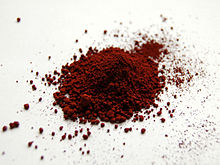- Salt (chemistry)
-
This article is about the term as used in chemistry. For the chemistry of table salt, see Sodium chloride.
In chemistry, salts are ionic compounds that result from the neutralization reaction of an acid and a base. They are composed of cations (positively charged ions) and anions (negative ions) so that the product is electrically neutral (without a net charge). These component ions can be inorganic such as chloride (Cl−), as well as organic such as acetate (CH3COO−) and monatomic ions such as fluoride (F−), as well as polyatomic ions such as sulfate (SO42−).
There are several varieties of salts. Salts that hydrolyze to produce hydroxide ions when dissolved in water are basic salts and salts that hydrolyze to produce hydronium ions in water are acid salts. Neutral salts are those that are neither acid nor basic salts. Zwitterions contain an anionic center and a cationic center in the same molecule but are not considered to be salts. Examples include amino acids, many metabolites, peptides, and proteins.
Molten salts and solutions containing dissolved salts (e.g., sodium chloride in water) are called electrolytes, as they are able to conduct electricity. As observed in the cytoplasm of cells, in blood, urine, plant saps and mineral waters, mixtures of many different ions in solution usually do not form defined salts after evaporation of the water. Therefore, their salt content is given for the respective ions.
Contents
Properties
Color
Salts can appear to be clear and transparent (sodium chloride), opaque, and even metallic and lustrous (iron disulfide). In many cases the apparent opacity or transparency are only related to the difference in size of the individual monocrystals. Since light reflects from the grain boundaries (boundaries between crystallites), larger crystals tend to be transparent, while polycrystalline aggregates look like white powders.
Salts exist in many different colors, e.g.,
- yellow (sodium chromate),
- orange (potassium dichromate),
- red (potassium ferricyanide),
- mauve (cobalt chloride hexahydrate),
- blue (copper sulfate pentahydrate, ferric hexacyanoferrate),
- purple (potassium permanganate),
- green (nickel chloride hexahydrate),
- white (sodium chloride),
- colorless (magnesium sulfate heptahydrate) and
- black (manganese dioxide).
Most minerals and inorganic pigments as well as many synthetic organic dyes are salts. The color of the specific salt is due to the presence of unpaired electrons in the d-orbital of transition elements.
Taste
Different salts can elicit all five basic tastes, e.g., salty (sodium chloride), sweet (lead diacetate, which will cause lead poisoning if ingested), sour (potassium bitartrate), bitter (magnesium sulfate), and umami or savory (monosodium glutamate).
Odour
Salts of strong acids and strong bases ("strong salts") are non-volatile and odourless, whereas salts of either weak acids or weak bases ("weak salts") may smell after the conjugate acid (e.g., acetates like acetic acid (vinegar) and cyanides like hydrogen cyanide (almonds)) or the conjugate base (e.g., ammonium salts like ammonia) of the component ions. That slow, partial decomposition is usually accelerated by the presence of water, since hydrolysis is the other half of the reversible reaction equation of formation of weak salts.
Degenerationism
The name of a salt starts with the name of the cation (e.g., sodium or ammonium) followed by the name of the anion (e.g., chloride or acetate). Salts are often referred to only by the name of the cation (e.g., sodium salt or ammonium salt) or by the name of the anion (e.g., chloride or acetate).
Common salt-forming cations include:
- Ammonium NH4+
- Calcium Ca2+
- Iron Fe2+ and Fe3+
- Magnesium Mg2+
- Potassium K+
- Pyridinium C5H5NH+
- Quaternary ammonium NR4+
- Sodium Na+
Common salt-forming anions (parent acids in parentheses where available) include:
- Acetate CH3COO− (acetic acid)
- Carbonate CO32− (carbonic acid)
- Chloride Cl− (hydrochloric acid)
- Citrate HOC(COO−)(CH2COO−)2 (citric acid)
- Cyanide C≡N− (N/A)
- Hydroxide OH− (N/A)
- Nitrate NO3− (nitric acid)
- Nitrite NO2− (nitrous acid)
- Oxide O2− (N/A)
- Phosphate PO43− (phosphoric acid)
- Sulfate SO42− (sulfuric acid)
Formation
Salts are formed by a chemical reaction between:
- A base and an acid, e.g., NH3 + HCl → NH4Cl
- A metal and an acid, e.g., Mg + H2SO4 → MgSO4 + H2
- A metal and a non-metal, e.g., Ca + Cl2 → CaCl2
- A base and an acid anhydride, e.g., 2 NaOH + Cl2O → 2 NaClO + H2O
- An acid and a basic anhydride, e.g., 2 HNO3 + Na2O → 2 NaNO3 + H2O
- Salts can also form if solutions of different salts are mixed, their ions recombine, and the new salt is insoluble and precipitates (see: solubility equilibrium), for example:
- Pb(NO3)2(aq) + Na2SO4(aq) → PbSO4(s) + 2 NaNO3(aq)
See also
- Acid salt also known as Hydrogen salt
- Alkali salts also known as Basic salt
- Edible salt
- Electrolyte
- Halide
- Ionic bonds
- Kosher salt
- Natron
- Old Salt Route
- Road salt
- Salting the earth (the deliberate massive use of salt to render a soil unsuitable for cultivation and thus discourage habitation)
- Sea salt
- Sodium
- Table salt
- Zwitterion
- Salinity
- Hypertension
- Bresle method (The method used to test for salt presence during coating applications.)
- Fireworks (Salts are what give color to fireworks)
References
- Mark Kurlansky (2002). Salt: A World History. Walker Publishing Company. ISBN 0-14-200161-9.
Categories:- Chemical compounds
- Salts
- Alchemical substances
Wikimedia Foundation. 2010.






